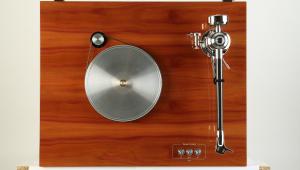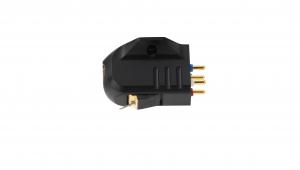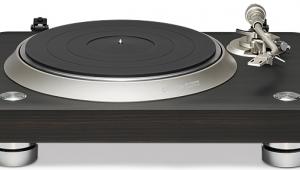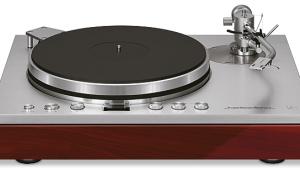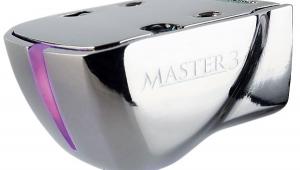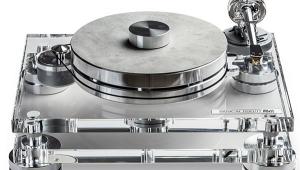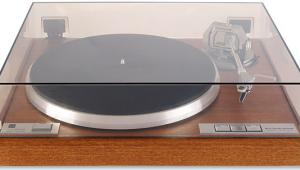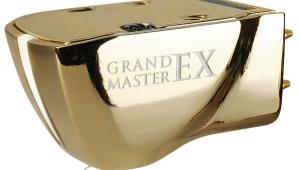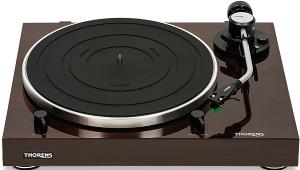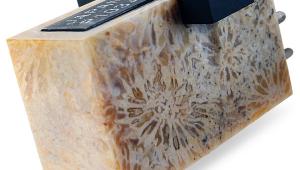Rega Rp8/rb808 Belt Driven Turntable With Electronic Speed Control (£1598 Inc Arm)

Thanks to this, Rega’s Roy Gandy was able to envisage a plinth construction that would be much lighter than in previous designs, so in the RP8 the plinth has given way to a very light skeletal chassis. From a functional point of view, the RP8 on its skeletal chassis is complete in itself but Rega has added a separate outer frame, using the same
foam-sandwich construction, to support a dust cover.
The two brace pieces are of different materials, to further reduce any resonances or airborne vibrations. The lower brace is made of a phenolic resin while the top one is magnesium. There are other innovations, most notably in the platter. Working with a young glass engineering company using the very latest CNC equipment, Gandy had found that it was possible to machine glass accurately enough to make a two-part glass platter – as in the RP6 [HFN Apr ’12].
A logical next step was the three-part stepped platter used here where, between main disc and outer ring, there’s now an additional, 6mm-thick middle ring.
The RP8 comes with the Rega TTPSU power supply; it produces a 24V AC signal with a claimed less than 0.1% distortion, unaffected by mains fluctuations or noise, to drive the motor, and provides switching for 33.3 and 45rpm. Each RP8 motor is hand-tuned and matched to its TTPSU, via an anti-vibration circuit built in under the deck. The usual single standard drive belt is replaced by two of Rega’s higher-grade belts.
Outwardly identifiable by its gloss paint finish, the new RB808 tonearm is based on the retooled casting introduced with the RB303, but with improved bearings and a tightened spindle-fit tolerance.
Reducing the mass of the turntable meant that the mass of the arm had to be reduced too. So a new and lighter vertical bearing assembly was designed.
As usual with Rega, cartridge tracking force is applied by a spring, controlled by a calibrated dial while a simple pull-out button applies the bias compensation. Finally, the audio signal emerges via newly-specified low capacitance phono cables.
Depth and detail
When it came to conveying depth or space in a recording, whether wholly natural or cunningly enhanced, the RP8 was very impressive indeed. The perennial Muddy Waters: Folk Singer [Discovery] demonstrated this very well, with Muddy’s voice sounding both intimate and tremendously powerful in the seemingly cavernous acoustic. On Waters’ incredible, emotive guitar, you could hear every detail as the bottleneck rasped on the wound strings. Buddy Guy’s clean-and-clear single-note obbligatos, on the second acoustic guitar, could be heard to come from his seated position to the rear right of the singer, just as you see in the original session photos. Willie Dixon’s bass was full and weighty – again seeming firmly placed in space.
We also felt the bass was outstandingly good on The King James Version [Sheffield Lab, direct-cut] with the Harry James band. The bass line had real precision and urgency, the ability to stop and start combining with a tight drum sound in a way that was both natural and also got your feet tapping.
Changing from a Benz Micro Glider SL to the excellent Ortofon Cadenza Black, gave a sound that was more analytical,
with an impression of precision rather than warmth. On a track like Clapton’s ‘I’ll Make Love To You Anytime’ its super-detailing paid off.
Another major feature of the RP8 was an increased ability to portray really low-level detail. For example, on the track
‘Fast Car’ [Tracy Chapman – Elektra] there’s a credit for Ed Black on steel guitar, but this instrument is mixed so far back
you could probably listen to the song 100 times without really noticing it. With the RP8, though, we found we picked up on it straight away.
Verdict
The RP8 embodies the fullest realisation of Roy Gandy’s ideas yet. It rewards with a sound that has depth, purity and realism that belies its moderate price. Its stylishness is just the icing on the cake.
Originally published in the 2014 Yearbook





